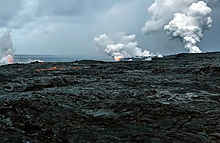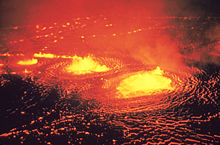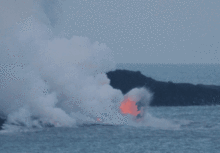Kīlauea
2008/9 Schools Wikipedia Selection. Related subjects: Central & South American Geography
| Kīlauea | |
|---|---|
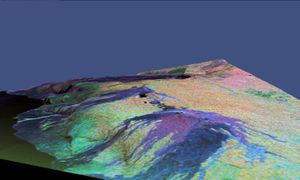 False colour picture of Kilauea |
|
| Elevation | 4,091 ft (1,247 m) |
| Location | Hawaii, USA |
| Range | Hawaiʻian Islands |
| Coordinates | |
| Type | Shield volcano |
| Volcanic arc/ belt | Hawaiʻian-Emperor seamount chain |
| Age of rock | < 23000 yrs |
| Last eruption | 1983- Present |
Kīlauea (IPA: [kiːlauea]) is an active volcano in the Hawaiian Islands, one of five shield volcanoes that together form the Island of Hawaiʻi. In Hawaiian, the word kīlauea means "spewing" or "much spreading", in reference to the mountain's frequent outpouring of lava. Issuing lava continuously since January 1983, Kīlauea is currently the most active volcano on the planet, an invaluable resource for volcanologists, and also the planet's most visited active volcano. Kīlauea is the most recent of a series of volcanoes that have created the Hawaiʻian Archipelago, as the Pacific Plate has moved and is moving over the Hawaiʻi hotspot (see Lōʻihi Seamount).
Description
Kīlauea is located on Hawaiʻi Island, Hawaiʻi, in the United States. It lies against the southeast flank of much larger Mauna Loa volcano. Mauna Loa's massive size and elevation (13,677 feet or 4,169 m) is a stark contrast to Kīlauea, which rises only 4,091 feet (1,247 m) above sea level, and thus from the summit caldera appears as a broad shelf of uplands well beneath the long profile of occasionally snow-capped Mauna Loa, 15 miles (24 km) distant.
Kīlauea is a very low, flat shield volcano — vastly different in profile from the high, sharply sloping peaks of stratovolcanoes like Mt. Fuji, Mount Hood, and Mount St. Helens.
Approach from Hilo
From Hilo, the belt highway, State Rte. 11, heads south to Keaʻau, then turns westward to begin the climb to the Kīlauea caldera. For some 20 miles (32 km) the road runs relatively straight, making a very gradual 4,000-foot (1,200 m) ascent. However, most of this climb is actually on the heavily vegetated, cloud forest flank of Mauna Loa. The crossing onto lava flows issued from Kīlauea is not until about 1-mile (1.6 km) west of Glenwood, 18 miles (29 km) from Hilo. The verdant, forested Mauna Loa flows are several thousand years old, whereas the lightly vegetated Kīlauea flows are only 350 to 500 years old.
Approach from Kona via Kaʻū
Driving south from Kailua-Kona on the west coast of Hawaiʻi, Kīlauea is 98 miles (158 km) distant along the belt highway, Rte. 11, which passes through Kaʻū, the southernmost district of the island. After passing around the southern end of Mauna Loa's lengthy lower flank, the highway then turns northeast towards Kīlauea. The route through Kaʻū is different from the verdant forests seen when coming from Hilo: The route from the south approaches Kīlauea through the Kaū Desert, on the volcano's leeward slope. Kīlauea's height of 4,000 feet (1,200 m) is sufficient to force most of the moisture out of the impinging northeasterly trade winds, leaving much of Kaʻū in the rain shadow of the "low" mountain, creating a desert effect. The desert effect is also produced by the acid rain resulting from sulfur dioxide emitted by the volcano. This area is also the very active southwest rift zone of Kīlauea, a prolific ash producer. Winds redistribute the ash, causing dust storms and dunes barren of most vegetation.
As from the Hilo side, the long gradual climb from near sea level to the summit is actually all on the flank of Mauna Loa. Not until the Sulfur Bank scarp (the northwestern edge of Kīlauea Caldera), near the intersection of Crater Rim Drive in Hawaiʻi Volcanoes National Park, does the road cross over onto Kīlauea. From near Punaluʻu at the coast to the caldera at the summit, the highway parallels the line of contact between the two volcanoes — always less than 1-mile (1.6 km) southeast of that line.
Kīlauea Caldera and Halemaʻumaʻu.
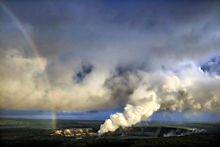
Hawaiʻi Volcanoes National Park encompasses a portion of Kīlauea, and the park visitor centre is located near the margin of the summit caldera, overlooking a large pit crater called Halemaʻumaʻu. The roughly circular caldera measures 3x5 km (or 6x6 km, including the outermost ring faults).
Kīlauea eruptions
Eruptions at Kīlauea occur primarily either from the summit caldera or along either of the lengthy East and Southwest rift zones that extend from the caldera and run approximately parallel to the coastline. In recent decades, eruptions have been continuous, with many of the lava flows reaching to the Pacific Ocean shore. About 90% of the surface of Kīlauea is lava flows less than 1,100 years old; 70% of the surface is younger than 600 years.
There were 45 eruptions of Kīlauea in the twentieth century. The Mauna Ulu eruption of Kīlauea began on May 24, 1969 and ended on July 22, 1974. At the time, Mauna Ulu was the longest flank eruption of any Hawaiian volcano in recorded history. The eruption created a new vent, covered massive amounts of land with lava, and added new land to the island. The Mauna Ulu eruption first started as a fissure between two pit craters, ʻĀloʻi and ʻAlae, where the Mauna Ulu shield would eventually form. Both pāhoehoe and ʻaʻā lava erupted from the volcano. Early on, fountains of lava burst out as much as 540 meters (1772 ft) high. In early 1973, an earthquake occurred that caused Kīlauea to stop erupting near the original Mauna Ulu site and instead erupt near the craters Pauahi and Hiʻiaka. However, the eruption site soon returned to normal. The 1990 lava flow was notable for its destruction of property.
Current vent eruption and lava flows
The current Kīlauea eruption began on January 3, 1983, along the East rift zone from the Puʻu ʻŌʻō vent and also the Kupaianaha vent, and continues to produce lava flows that travel 11 to 12 km from these vents to the sea. This eruption has covered over 117 km² of land on the southern flank of Kīlauea and has built out into the sea 2 km² (230 hectares) of new land. Since 1983 more than 2.7 km³ of lava has been erupted, making the 1983-to-present eruption the largest historically known for Kīlauea. 189 structures have been destroyed. In the early to middle 1980s Kīlauea was known as "The Drive-By Volcano" because anyone could ride by and see the lava fountains — some as much as 1,000 feet (300 m) in the air — from their car.
In the 1990 lava flow the towns of Kalapana and Kaimū were totally destroyed, as were Kaimū Bay, Kalapana Black Sand Beach, and a large section of State Rte. 130, which now abruptly dead-ends at the lava flow. While Kīlauea is known for its largely non-explosive eruptions, it has a darker side to it: It has had large explosive eruptions in the past. The most recent of such explosive eruptions occurred in 1924, when magma interacted with groundwater as the long-standing lava lake in Halemaʻumaʻu Crater drained. Even larger ones have occurred, including one in 1790, which killed at least several dozen people. Eruption columns are inferred to have gone at least as high as 9 km (5.6 miles) and even up to 15-20 km (9-12 miles) in altitude — much higher than the cruising altitude of airliners.
Eruptions from Kīlauea also are known for creating vog, or volcanic smog, which affects many areas of the Hawaiʻian Islands, including Oʻahu and Honolulu whenever winds come out of the south or southeast.
Lava from Kīlauea destroyed three abandoned houses in the week of February 25, 2008 in a nearly deserted neighbourhood. On the night of March 5, 2008, lava from the flows again reached the ocean off the Puna coast, creating a spectacular show of light and color. Hawaii County Civil Defense officials have set up a viewing centre nearby for the public to observe the phenomenon.
2008 summit crater explosion
In the early morning hours of March 19, 2008, Halemaʻumaʻu experienced its first explosive event since 1924 and the first eruption in the Kīlauea caldera since September 1982. A steam vent that had recently opened near the overlook area exploded, generating a magnitude 3.7 earthquake, and scattering rocks over a 75 acre area. A small amount of ash was also reported at a nearby community. The explosion debris covered part of Crater Rim Drive and damaged Halemaʻumaʻu overlook. The explosion did not release any lava, which suggests to scientists that it was driven by hydrothermal or gas sources.
This explosion event followed an increased sulfur dioxide gas levels from the Halemaʻumaʻu crater. The dangerous increase of sulfur dioxide gas has prompted closures of Crater Rim Drive between Kilauea Military Camp south/southeast to Chain of Craters Road, Crater Rim Trail from Kilauea Military Camp south/southeast to Chain of Craters Road, and all trails leading to Halemaʻumaʻu crater, including those from Byron Ledge, ʻIliahi (Sandalwood) Trail, and Kaʻu Desert Trail.
Early in the morning of March 24, 2008, the white gas ejection changed to brown-gray ash, and lava particles were thrown from the vent, forming Pele's Hair, Pele's Tears, and 4-inch (100 mm) lava spatters around the vent. This is the first time fresh lava has been erupted in the crater since 1982.
Pele
Kīlauea is considered to be the present home of Pele, the volcano goddess of ancient Hawaiʻian legend. Several special lava formations are named after her, including Pele's Tears (small droplets of lava that cool in the air and retain their teardrop shapes) and Pele's Hair (thin, brittle strands of volcanic glass that often form during the explosions that accompany a lava flow as it enters the ocean).
In Hawaiian mythology, Kīlauea is where most of the conflict between Pele and the rain god Kamapuaʻa took place. Halemaʻumaʻu, "House of the ʻamaʻumaʻu fern", derives its name from the final struggle between the two gods: since it was the favorite residence of Pele, Kamapuaʻa, hard-pressed by Pele's ability to make lava spout from the ground at will, covered it with the fronds of the fern. Choking from the smoke which could not escape anymore, Pele emerged. Realizing that each could threaten the other with destruction, the gods had to call their fight a draw and divided the island between them: Kamapuaʻa got the windward northeastern side, and Pele got the drier Kona (" leeward") side. The rusty singed appearance of the young fronds of the ʻamaʻumaʻu was said to be a product of the legendary struggle.
